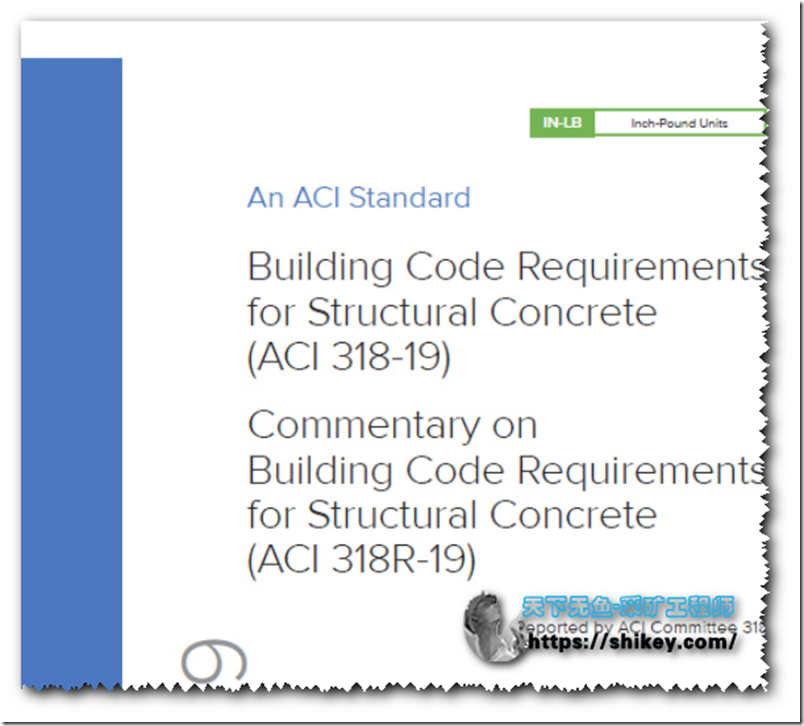书籍简介
“结构混凝土的建筑规范要求”(“规范”)对结构混凝土建筑物以及适用的非建筑结构的材料,设计和细节提供了最低要求。该规范是由ANSI批准的共识程序开发的,涉及结构系统,构件和连接,包括现浇,预制,喷射混凝土,平原,非预应力,预应力和复合结构。涉及的主题包括:强度,可维修性和耐用性的设计和构造;荷载组合,荷载系数和强度折减系数;结构分析方法;挠度极限 机械和粘合剂锚固到混凝土上;钢筋的开发和拼接;施工文件信息;现场检查和测试;
该准则在2014年进行了重大重组和重新格式化,并且该准则继续并扩展了相同的组织理念。重组的主要目的是在专门针对这些主题的章节中提出结构系统或单个成员的所有设计和详细要求,并按照总体上遵循设计和建造过程和时间顺序的方式来安排章节。实用程序一章中提供了多个成员设计所共有的信息和过程。本规范中实现的其他增强功能旨在提供更高的清晰度和易用性,包括首次使用彩色插图和使用彩色来帮助用户浏览本规范并快速找到所需的信息。特别感谢Bentley Systems,Incorporated,
本规范的用途包括在一般建筑规范中作为参考采用,并且以前的版本已以这种方式广泛使用。本规范以允许在不更改其语言的情况下进行引用的格式编写。因此,执行守则规定要求或意图的背景细节或建议不能纳入守则本身。为此提供了评注。
评注中讨论了委员会在制定《守则》时的一些注意事项,重点是对新规定或修订规定的解释。对于希望更详细地研究单个问题的用户,引用了准备《准则》时引用的许多研究数据。还引用了其他文件,这些文件为执行《守则》的要求提供了建议。
关键词:外加剂;骨料 锚固(结构);梁柱框架 梁(支撑);沉箱; 水泥; 寒冷的天气; 柱(支撑);综合压力 复合结构(混凝土)抗压强度; 具体; 施工文件;施工缝;连续性(结构);伸缩缝;盖; 养护; 深光束 深厚的基础;挠度 钻孔墩;抗震结构;抗弯强度; 地板; 立足点 模板(建筑);热的天气; 检查; 隔离接头;关节(交界处);托梁 轻质混凝土;负载测试(结构);负载(力);混合比例 弹性模量 时刻 堆 放置 普通混凝土; 预制混凝土 预应力混凝土; 预应力钢;质量控制;钢筋混凝土 增强钢;屋顶 可维护性;剪切强度 喷射混凝土 跨度 拼接 强度分析;压力 结构分析; 结构设计;结构完整性;结构墙;T型梁 扭转 墙; 水; 焊丝增强。
The “Building Code Requirements for Structural Concrete” (“Code”) provides minimum requirements for the materials, design, and detailing of structural concrete buildings and, where applicable, nonbuilding structures. This Code was developed by an ANSI-approved consensus process and addresses structural systems, members, and connections, including cast-in-place, precast, shotcrete, plain, nonprestressed, prestressed, and composite construction. Among the subjects covered are: design and construction for strength, serviceability, and durability; load combinations, load factors, and strength reduction factors; structural analysis methods; deflection limits; mechanical and adhesive anchoring to concrete; development and splicing of reinforcement; construction document information; field inspection and testing; and methods to evaluate the strength of existing structures.
The Code was substantially reorganized and reformatted in 2014, and this Code continues and expands that same organizational philosophy. The principal objectives of the reorganization were to present all design and detailing requirements for structural systems or for individual members in chapters devoted to those individual subjects, and to arrange the chapters in a manner that generally follows the process and chronology of design and construction. Information and procedures that are common to the design of multiple members are located in utility chapters. Additional enhancements implemented in this Code to provide greater clarity and ease of use include the first use of color illustrations and the use of color to help the user navigate the Code and quickly find the information they need. Special thanks to Bentley Systems, Incorporated, for use of their ProConcrete software to produce many of the figures found in the Commentary.
Uses of the Code include adoption by reference in a general building code, and earlier editions have been widely used in this manner. The Code is written in a format that allows such reference without change to its language. Therefore, background details or suggestions for carrying out the requirements or intent of the Code provisions cannot be included within the Code itself. The Commentary is provided for this purpose.
Some considerations of the committee in developing the Code are discussed in the Commentary, with emphasis given to the explanation of new or revised provisions. Much of the research data referenced in preparing the Code is cited for the user desiring to study individual questions in greater detail. Other documents that provide suggestions for carrying out the requirements of the Code are also cited.
Keywords: admixtures; aggregates; anchorage (structural); beam-column frame; beams (supports); caissons; cements; cold weather; columns (supports); combined stress; composite construction (concrete to concrete); compressive strength; concrete; construction documents; construction joints; continuity (structural); contraction joints; cover; curing; deep beams; deep foundations; deflections; drilled piers; earthquake-resistant structures; flexural strength; floors; footings; formwork (construction); hot weather; inspection; isolation joints; joints (junctions); joists; lightweight concretes; load tests (structural); loads (forces); mixture proportioning; modulus of elasticity; moments; piles; placing; plain concrete; precast concrete; prestressed concrete; prestressing steels; quality control; reinforced concrete; reinforcing steels; roofs; serviceability; shear strength; shotcrete; spans; splicing; strength analysis; stresses; structural analysis; structural design; structural integrity; structural walls; T-beams; torsion; walls; water; welded wire reinforcement.
书籍信息
ACI,2019年
pdf,628页,英文
国际标准书号(ISBN):978-1-64195-056-5
结构混凝土的建筑规范要求(ACI 318-19)
关于结构混凝土的建筑规范要求的说明(ACI 318R-19)



内容很好,谢谢分享